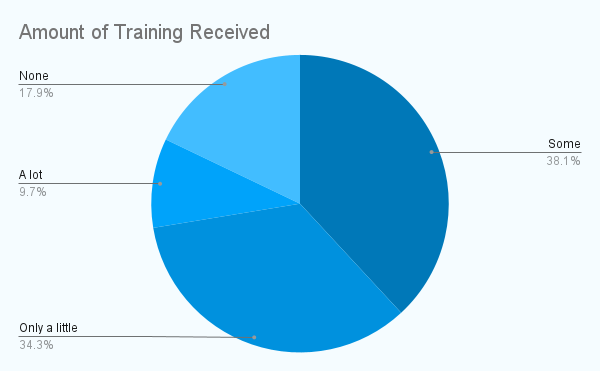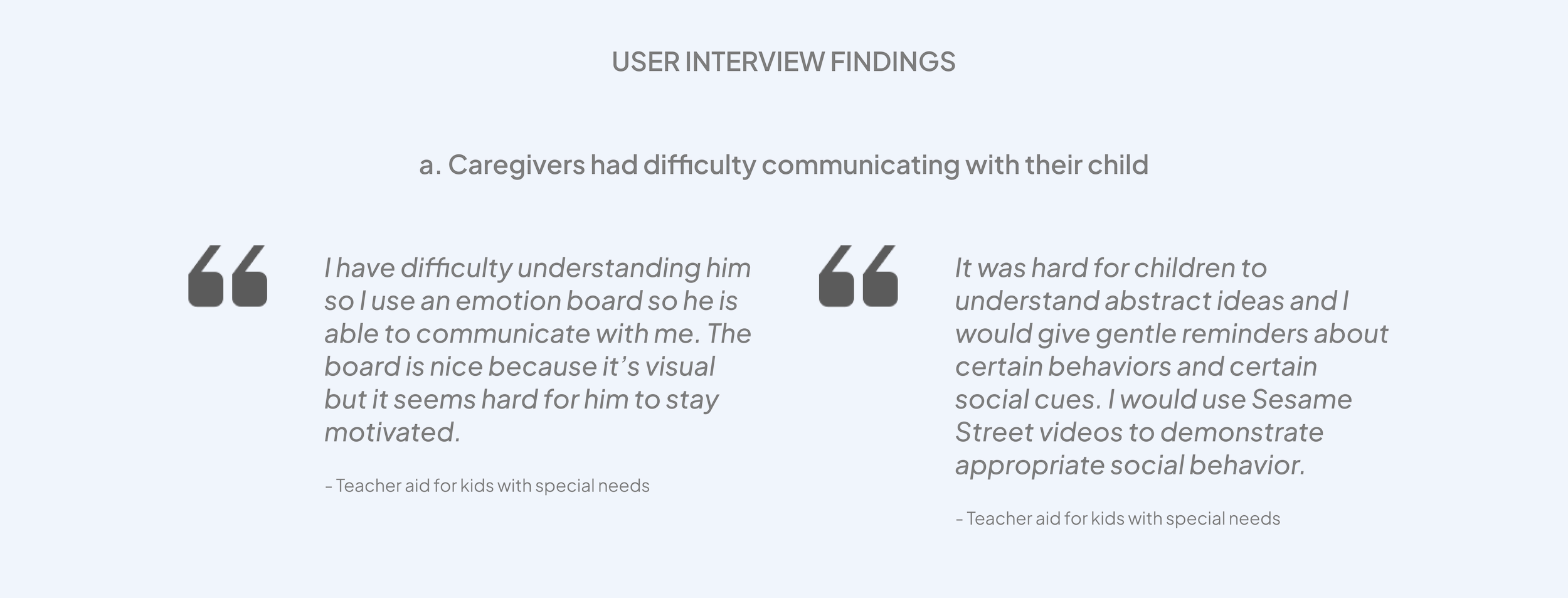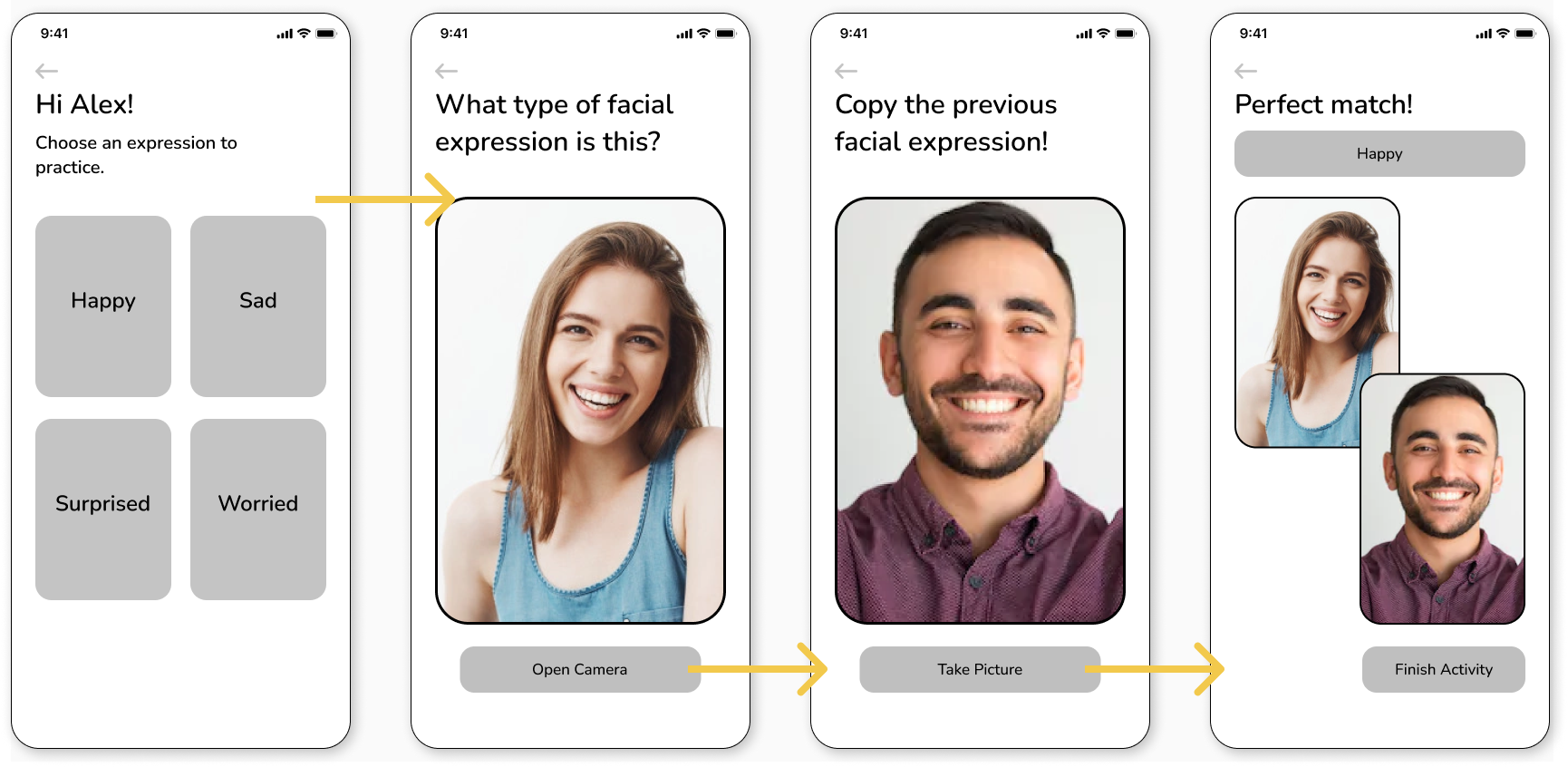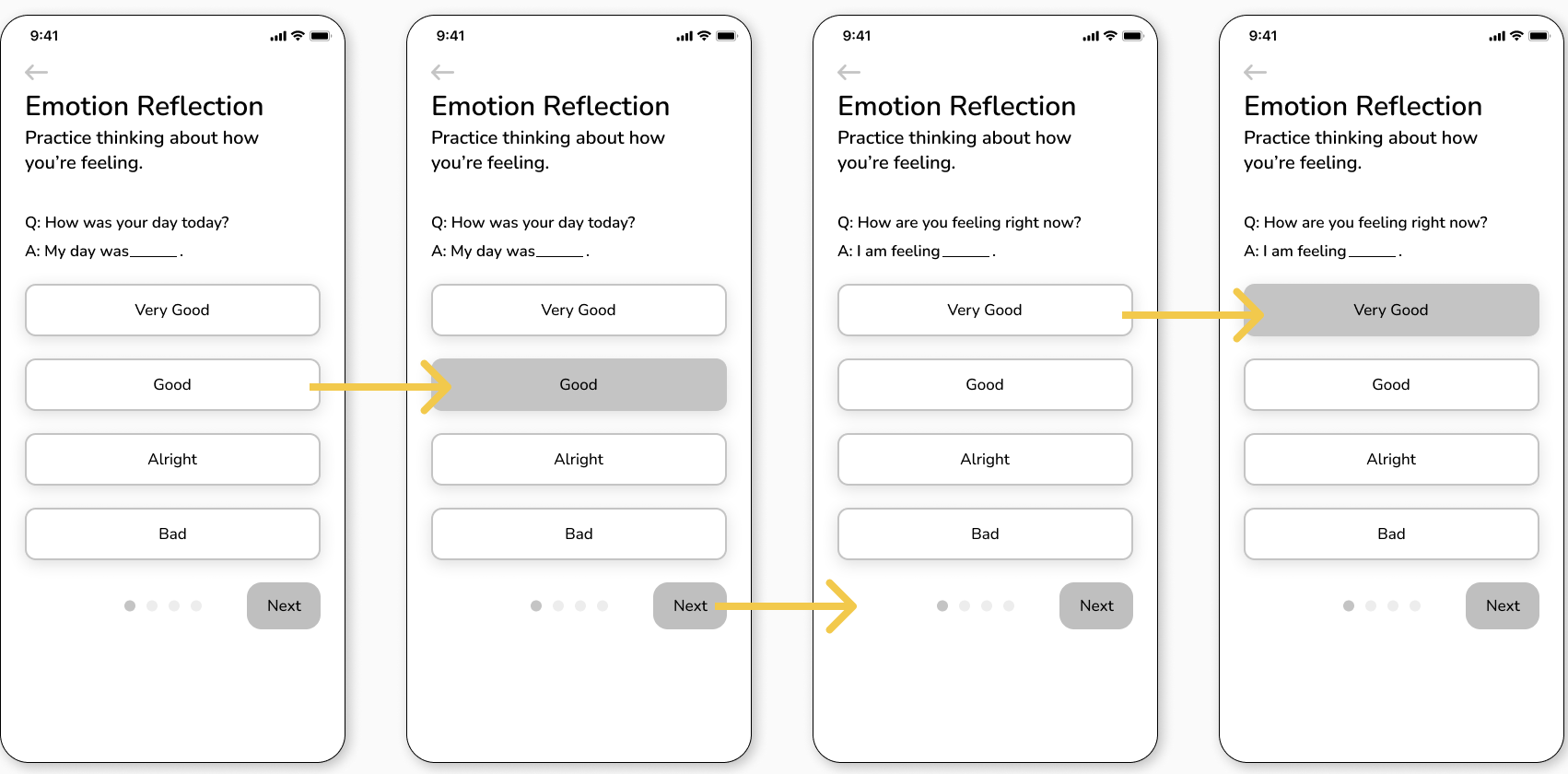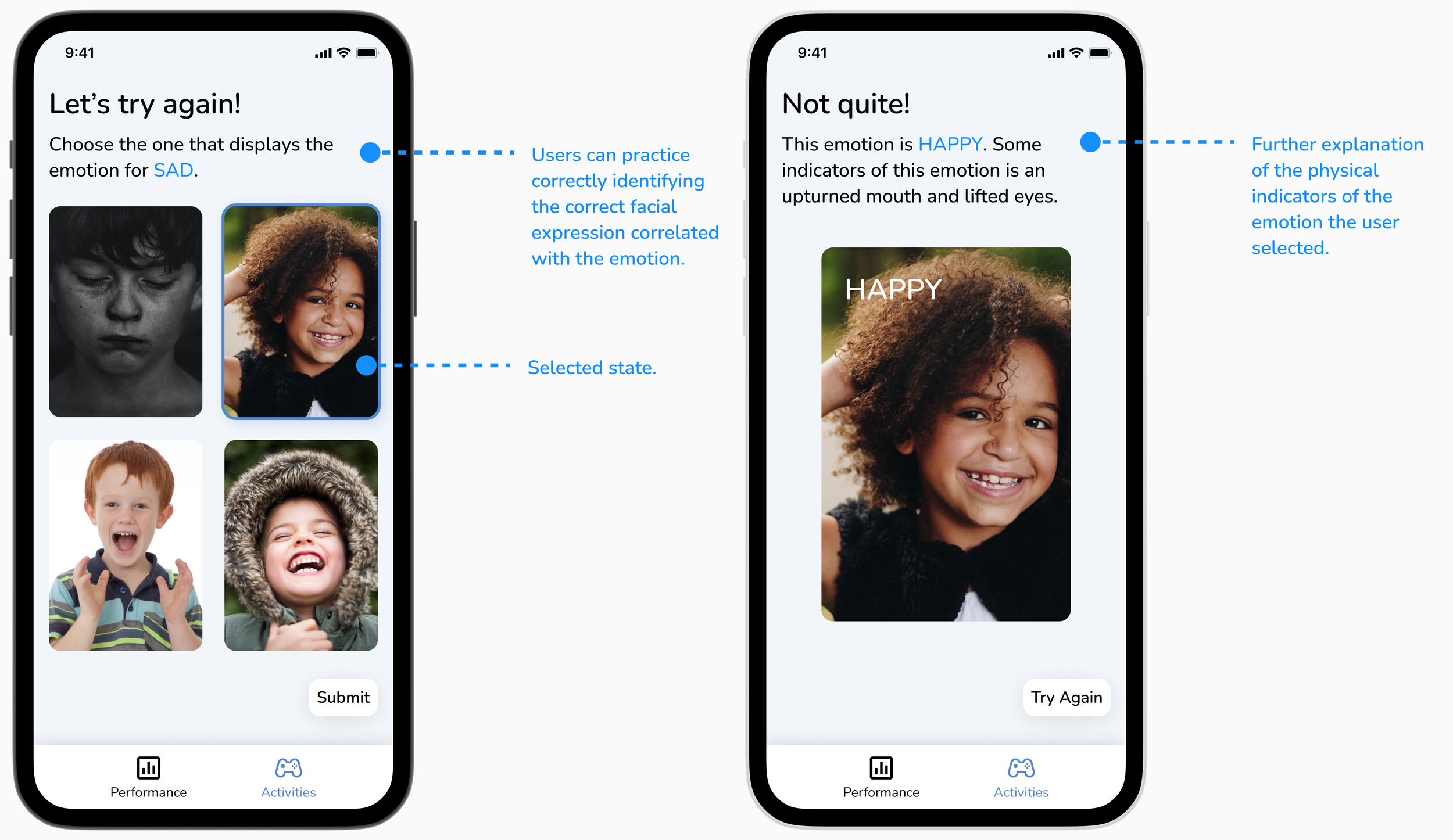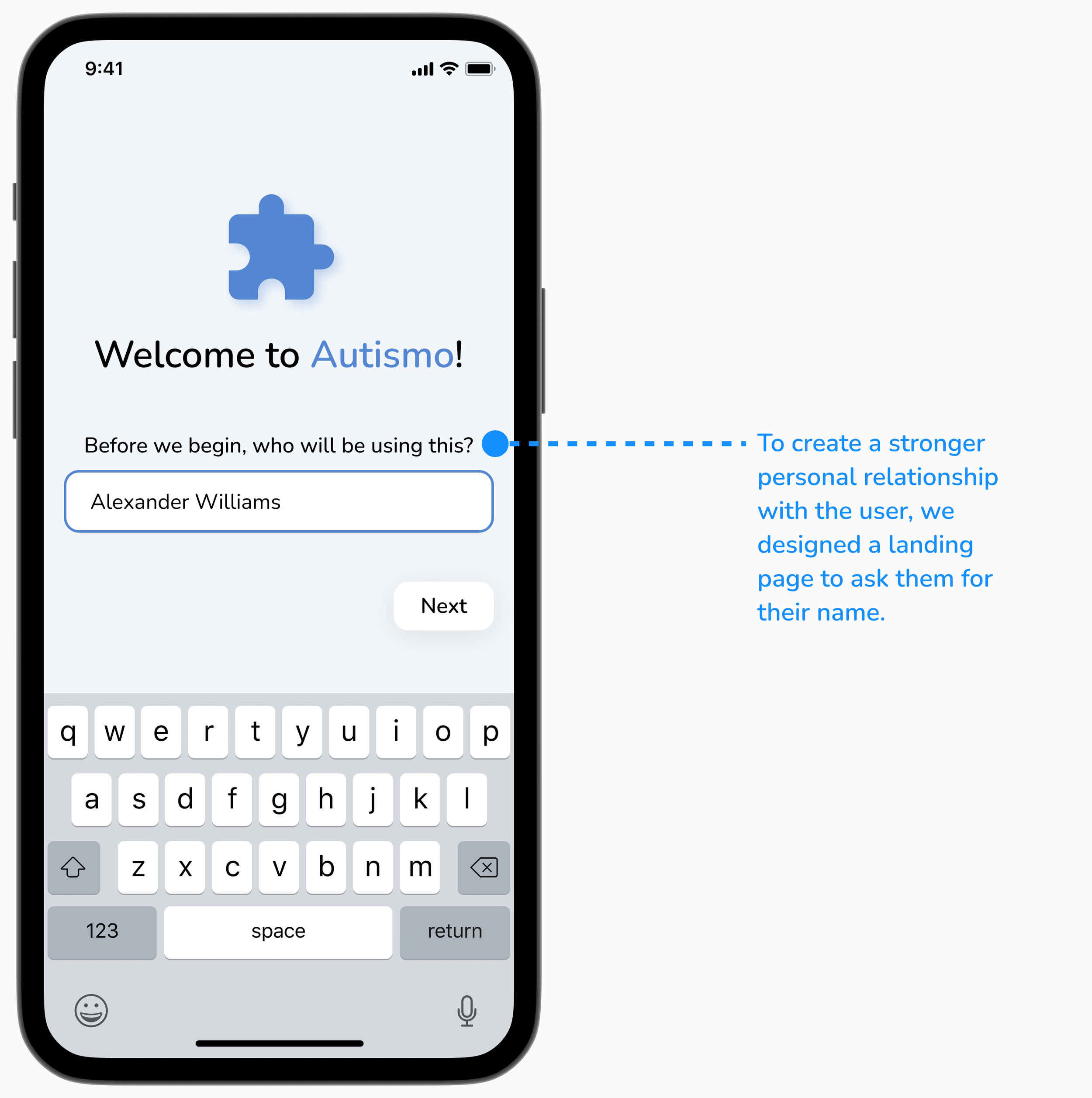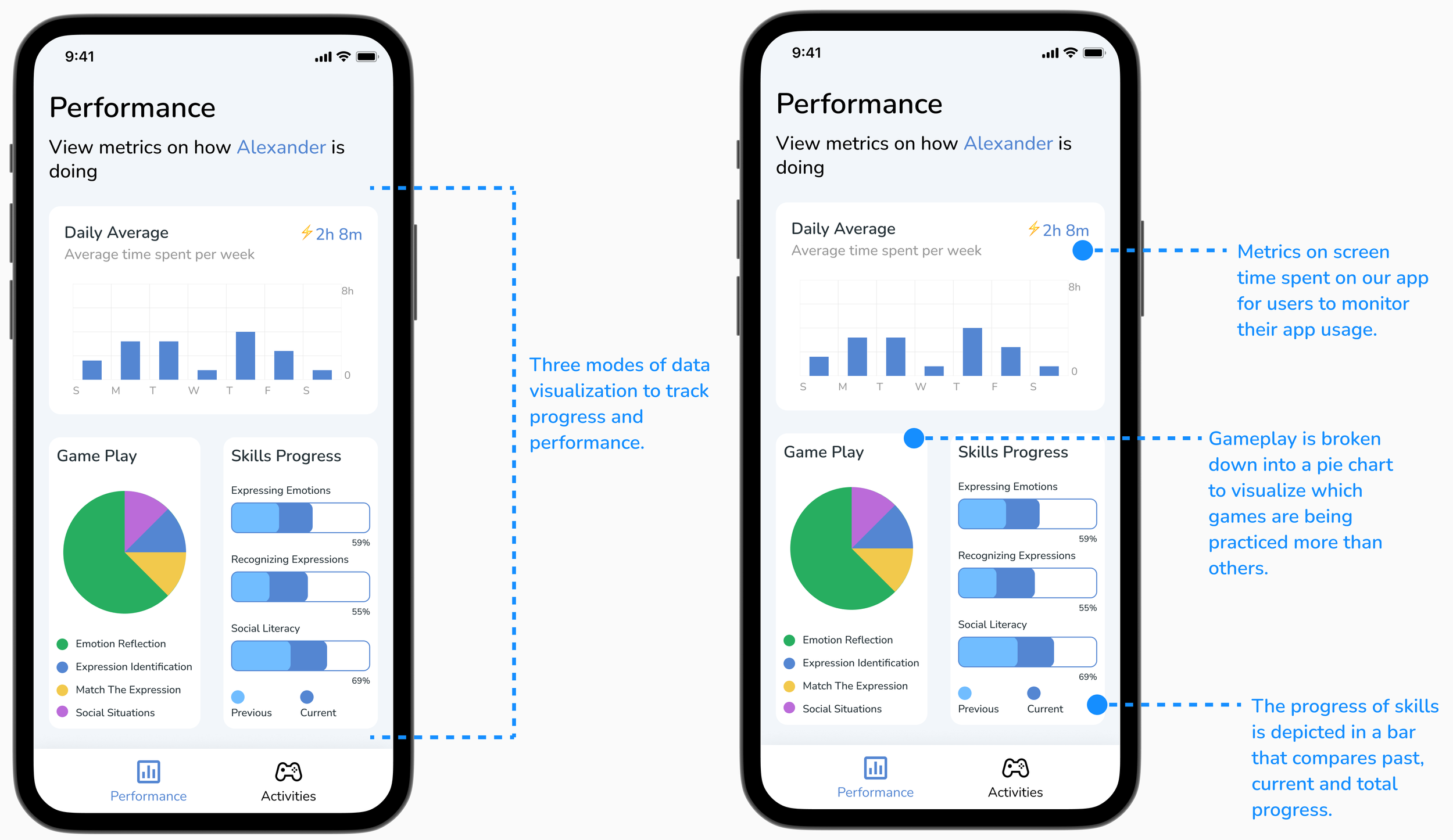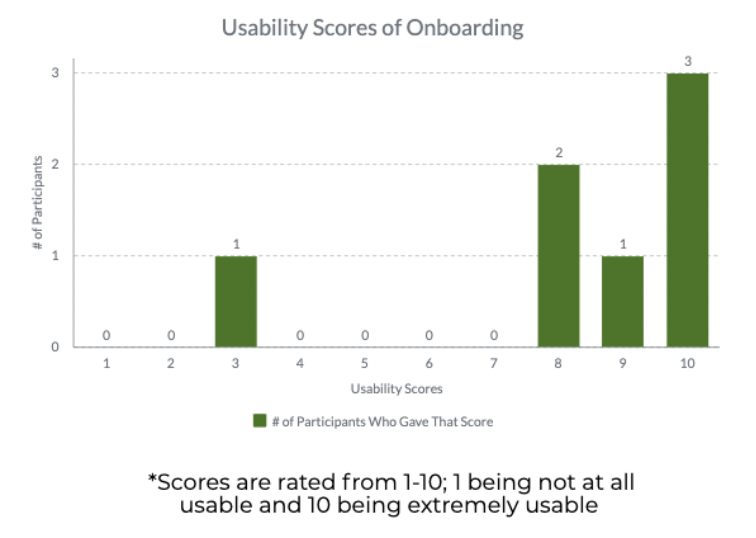Autismo
A gamified educational app for children with autism and their caregivers.
Group student project for User Experience for Interactive Media at UCSC in 2020.
Timeline
September - December 2020(10 weeks).
My Role
UX Designer and Researcher in a group student project.
Project Overview
Few educational apps for emotional literacy
In Fall of 2020, my group and I designed an app to provide a gamified learning experience for children with ASD to practice their emotional literacy and personal expression. After researching existing guided learning apps, we felt there was a limited amount of assistive apps that incorporated social and emotional expression building for this community. The lack of support in this area seemed to further a disconnect between the caregivers and their child.
Preliminary Research
Limited support for assistive technologies
We began to review academic research articles about assistive technology use between caregivers and their children with ASD. In a 2011 paper by Cardon and colleagues, we found that less than half of the caregivers who reported having trouble in their routines used solutions that incorporated assistive technology. Cardon et. al suggest this is due to a lack of support and accessibility.
Cardon, T. A., Wilcox, M. J., & Campbell, P. H. (2011). Caregiver Perspectives About
Assistive Technology Use With Their Young Children With Autism Spectrum Disorders. Infants & Young Children, 24(2), 153-173. doi:10.1097/iyc.0b013e31820eae40Communication was a barrier for our users
We conducted one-on-one user interviews to learn how children with ASD practice their social-emotional communication skills independently and in tandem with their caregivers. Although our primary user was children with ASD, we realized that communication might be constrained, so we relied on the child’s caregiver for much of our data.
We found that some common tools children with ASD and caretakers use were communication boards, educational videos, calming exercises, and IEPs(individualized education programs). While these tools were effective in some areas, caregivers still struggled with fully understanding their child and with finding diversified learning exercises for their child.
The Problem
“How might technology be used to help with a common frustration in our users’ routines—emotional understanding and communication independence?”
A consistent frustration between caregivers and children with ASD is the communication barrier between both parties. In order to bridge this gap, caregivers look towards assistive technologies to understand and communicate with their child. However, they often could not find easily accessible apps that incorporated a learning plan and fostered learning independence in the long term.
Personas
Goals
Build emotional literacy skills
Based on the research, we believe there is a gap between the products available in the market and users’ expectations. Currently, our users are looking for a place where they can practice emotional literacy and social independence. We wanted our users to feel supported by a learning program to strengthen their emotional comprehension skills. Through our preliminary research, we determined key design requirements for our product.
Design Requirements
Non-Disruptive
All of the users wanted a product that was simple and straightforward. The solution needs to be mindful of the cognitive load that is put on the users so the learning experience is able to remain unencumbered by additional frustrations. The visual design should be conscientious of the use of colors and sounds for users who have sensory sensitivities.
Immersive
The caregivers conveyed that it was difficult to keep their child interested in the learning activities they would participate in. The solution should create an engaging experience that entices continual use for the user. From the research, we learned that visual and auditory features were useful in capturing the users’ attention.
Personalized
Through our user interviews, we realized a technology that is effective for one user may not work for another due to the broad spectrum of ASD. The solution should provide a tailored experience, taking into consideration the varying learning capabilities, sensitivities, and difficulties of the users.
Initial Concepts
Facial Technology
A mobile app using facial technology for memory and facial recognition games using photos of the people in their life.
Progress Tracking App
A progress tracking app that helps caregivers and counselors track social-emotional skill-building levels of their child.
Community Forum
A forum for caregivers to connect with and support other caregivers with ASD-related issues.
Gamified Learning
A collection of games, targeting topics such as expression identification, emotion reflection, matching facial expressions, and behavior in social situations.
Platformer Game
A single-player video game where users navigate through different social scenarios in the context of someone with ASD.
CYOA Game
A choose your own adventure game to practice common real-world scenarios.
Final Concept
Gamified Learning
We began to evaluate our initial concepts considering our user personas and design requirements. Looking back at our personas, we see that Charlie, our primary persona, enjoys playing with toys and his iPad as well as engaging in repetitive tasks. Rebecca, our secondary persona, wants Charlie to develop social independence and emotional literacy. Informed by our personas, we decided that Gamified Learning met Charlie’s interest in games and Rebecca’s desire for Charlie to build emotional literacy skills.
User Flows
Expression Identification
We designed an expression identification game in which users can practice recognizing common facial expressions. The game aimed to build emotional literacy so users are able to correctly identify emotions and further demonstrate understanding by learning how to display emotions.
Match The Expressions
Continuing with emotional comprehension, we designed a game for users to match facial expressions with their correlated emotions. In this game, users are able to become familiar with certain features that are indicative of an emotion.
Emotion Reflection
In our initial user interviews, caregivers expressed experiencing difficulty with understanding how their child feels. We designed a learning exercise to prompt conversations between the child and their caregiver that would allow the child to practice emotional introspection.
Social Situations Flashcards
A common theme we saw in our research was an emphasis on practicing and understanding appropriate social behavior. We designed a learning exercise illustrating various social scenarios for the child and their caregiver to practice communication and behavioral skills in common social contexts.
Usability Testing
Process
We conducted a usability study on our low-fidelity prototypes and redesigned our product considering user feedback. We recruited a total of 7 participants through our social channels.
These are some of the questions we asked:
What are your general impressions of the app?
How do you think the app could be improved?
Does this game seem like a game your child with ASD would want to play?
Iterations
Expression Identification
Caretakers were concerned that a child could simply memorize and recreate an expression without understanding it.
Extended Game Experience
We added a fail state for users that have incorrectly recreated an expression. The users are presented with a selection of facial expressions and can learn about the physical characteristics that are indicative of an emotion.
Included Fail State
Onboarding Flow
To make our users feel welcome when they use our app, we refer to them by name throughout their experience.
Landing Page
After our user feedback, we incorporated an onboarding questionnaire for users so they could personalize their learning experience based on their sensitivities, strengths, and areas for improvement.
Onboarding Questionnaire
Performance Tab
In our usability test, caregivers mentioned that they would like to see some way to track the progress of their child. We took this into consideration and designed a tab for users to review their performance.
Metrics and Improvements
Final Research
Study Methods
For our final research, we wanted to collect both qualitative and quantitative measures. We did this by conducting moderated and unmoderated usability studies for qualitative data and by administering a post-study survey using semantic scales for quantitative data.
Some of our Research Questions:
Does our technology improve social and emotional skills?
Would users want to download our app?
How easy or difficult is the onboarding flow?
Reflections
Limited Capacity
Since our project was limited by time and resources, we believe that our product needs further research and iteration for us to fully understand the long-term effects on our users. We propose a longitudinal study that would reveal behavioral trends that might hint at improvement.
Even though we were limited to an eight-week project and were unable to achieve this, we discovered that many caregivers believed that our product would be useful for their child.
More Game Variations
Although they liked how straightforward the product was, they could understand how not everyone with ASD would benefit from it. Many caregivers stated that they would decide whether to carry on with the app based on how their child continued to respond to the games. While using the app, the majority of users showed neutral or favorable facial expressions.
For future designs, we think it would be beneficial to include a wide breadth of games to target nuanced learning areas for individuals with ASD.
Onboarding Received Positive Feedback
The simplicity and personalization of the onboarding process were well-received by the caregivers and they appreciated the ability to tailor the product to the autistic person's sensitivities and hobbies.
Importance of Personalization
Through our research, we learned the importance of customization and personalization in our product because of the broad spectrum of abilities and sensitivities that is a part of the ASD spectrum and structure our users’ needs. Although we received generally positive feedback on our design, we realized our product was lacking extensive research about the different types of autism and more background research would be needed to provide a comprehensive experience to all individuals on the spectrum.

